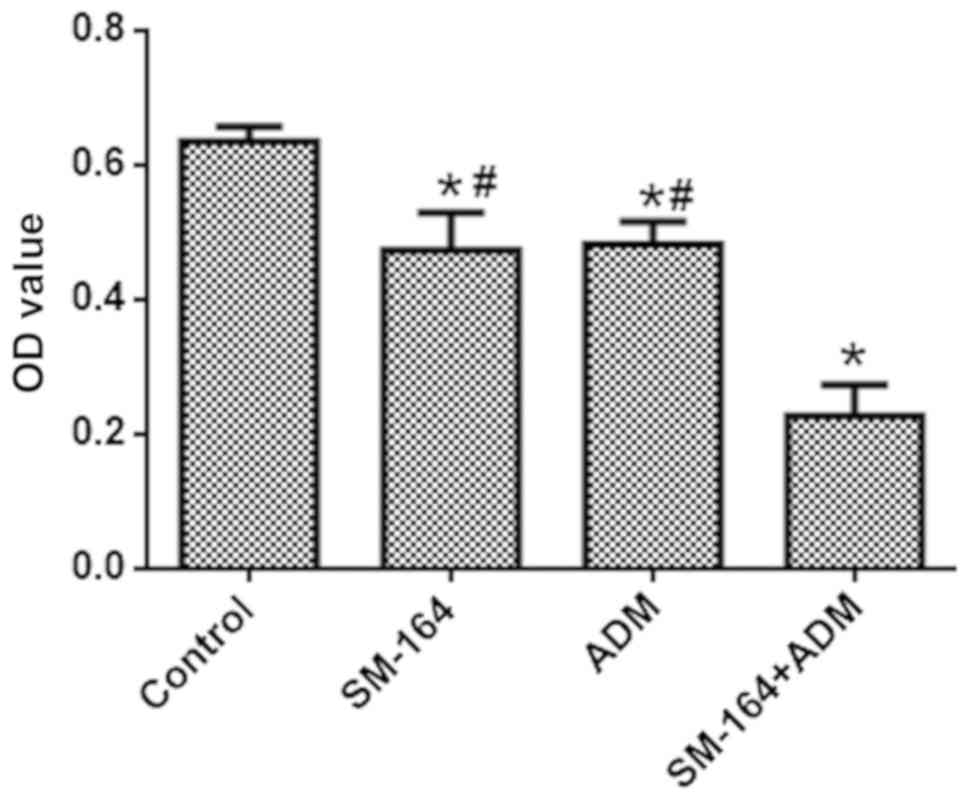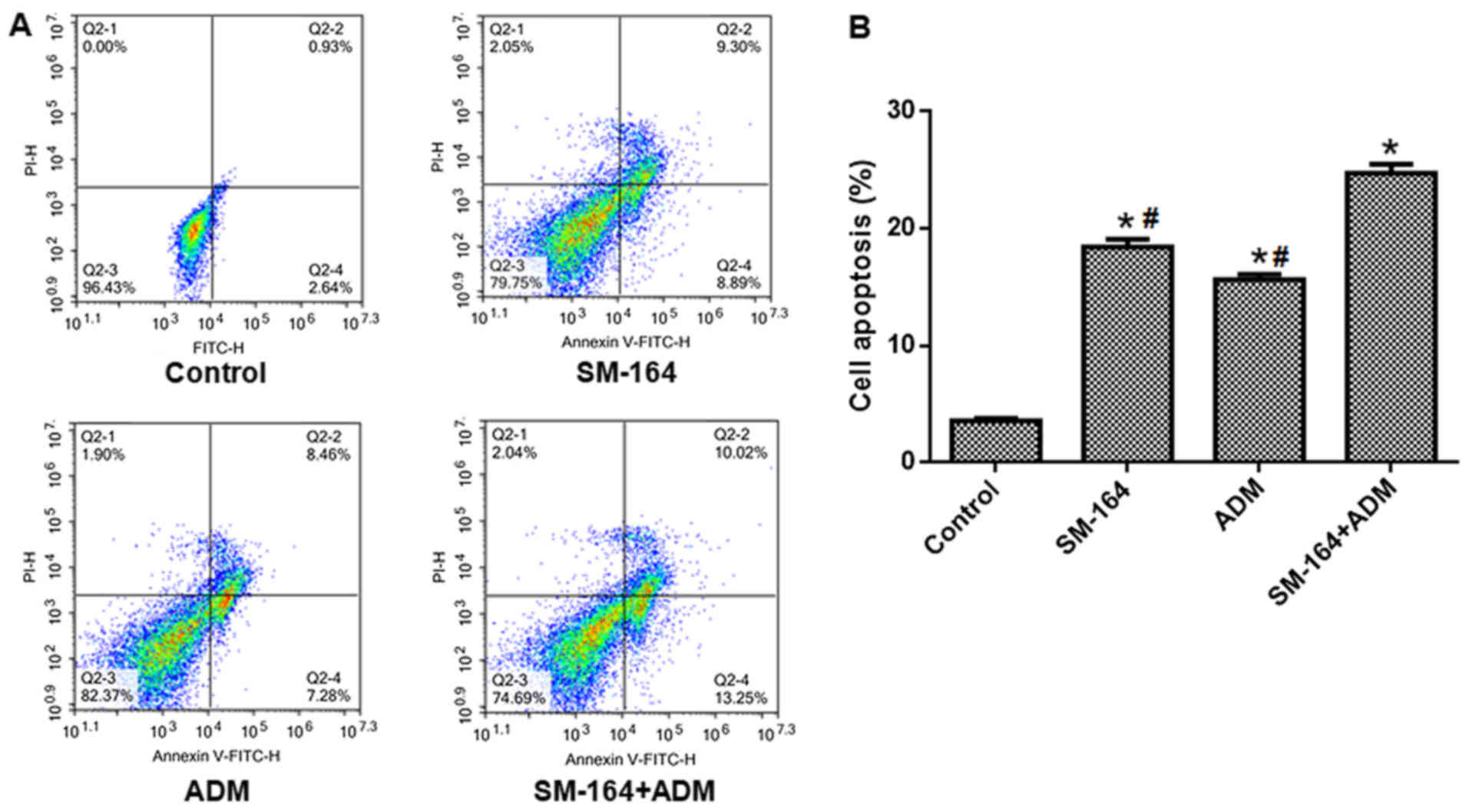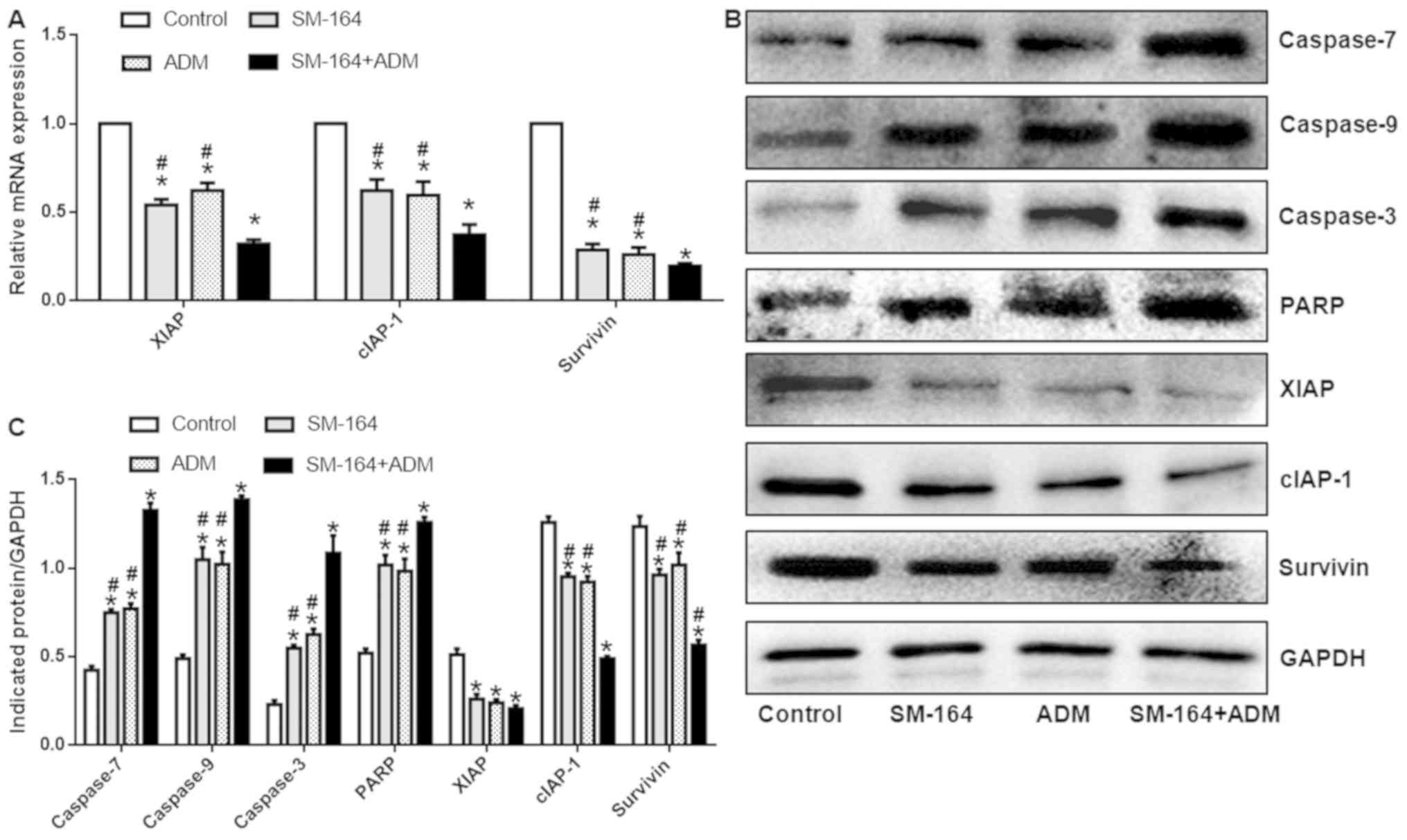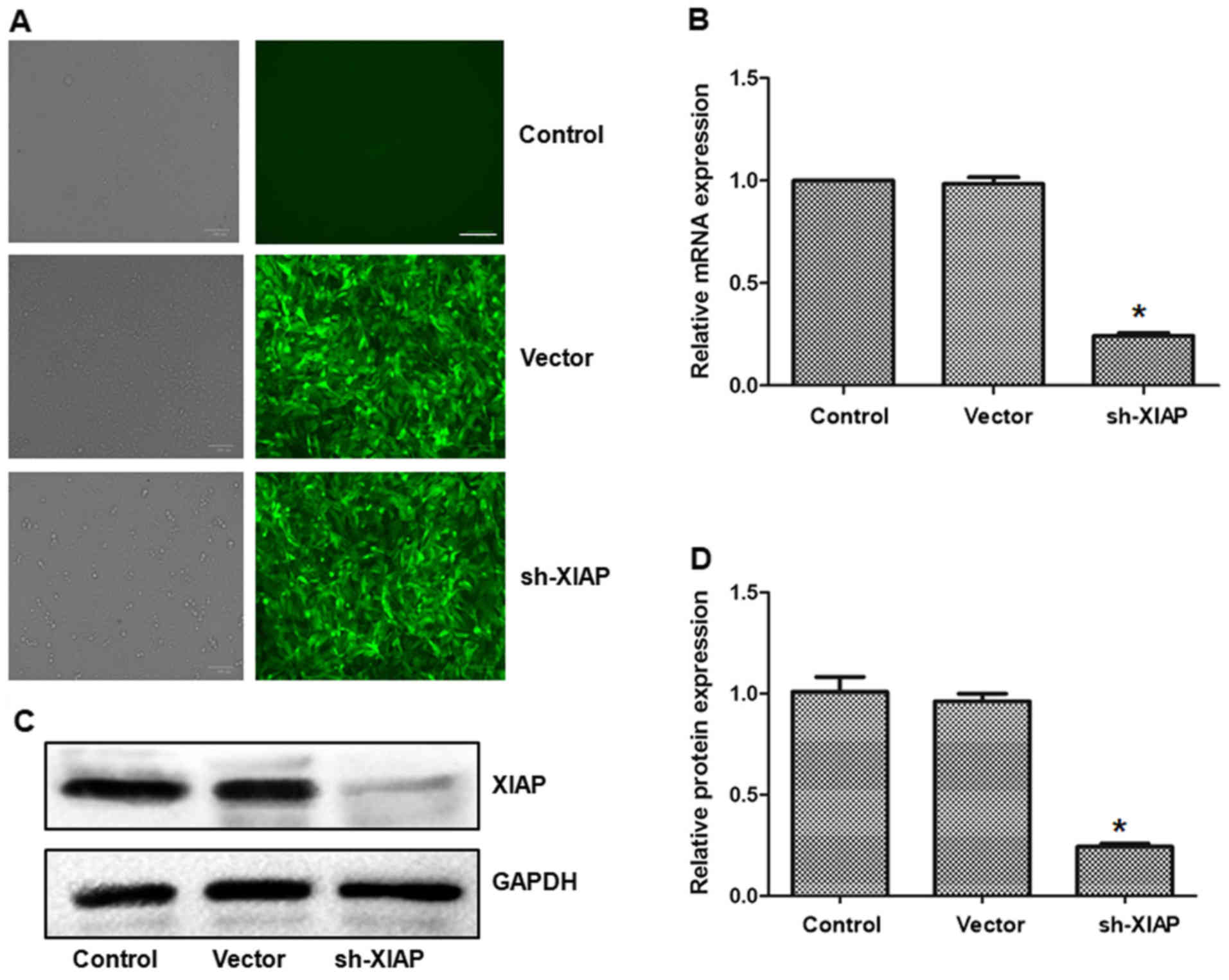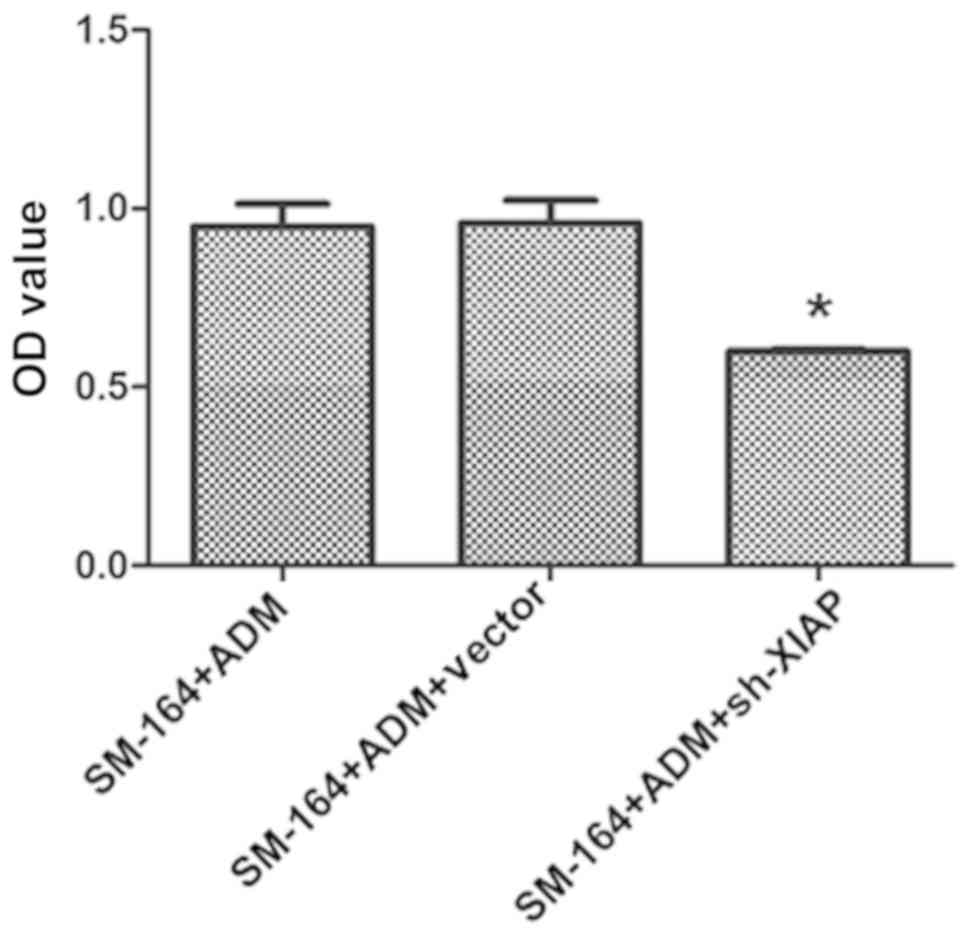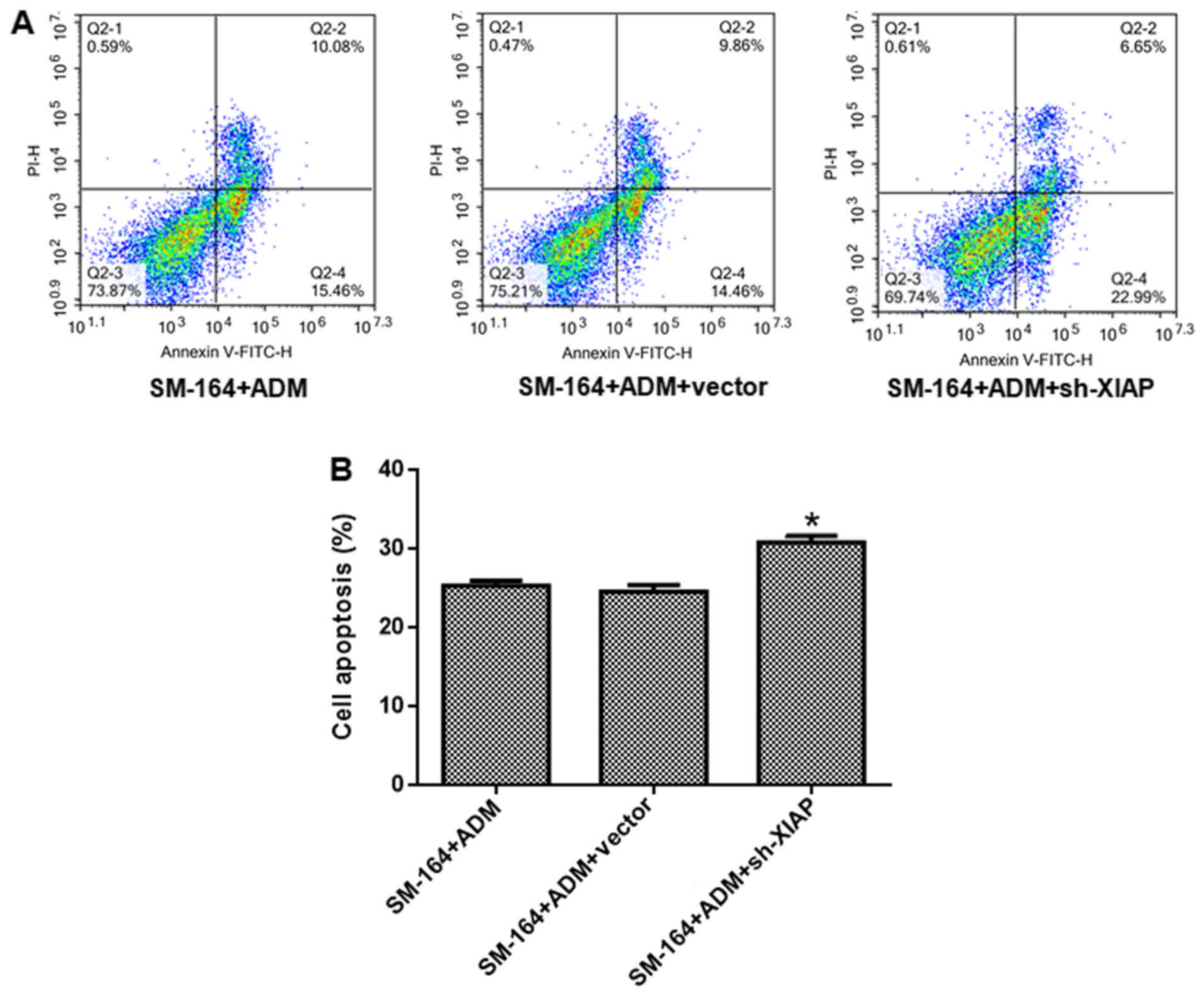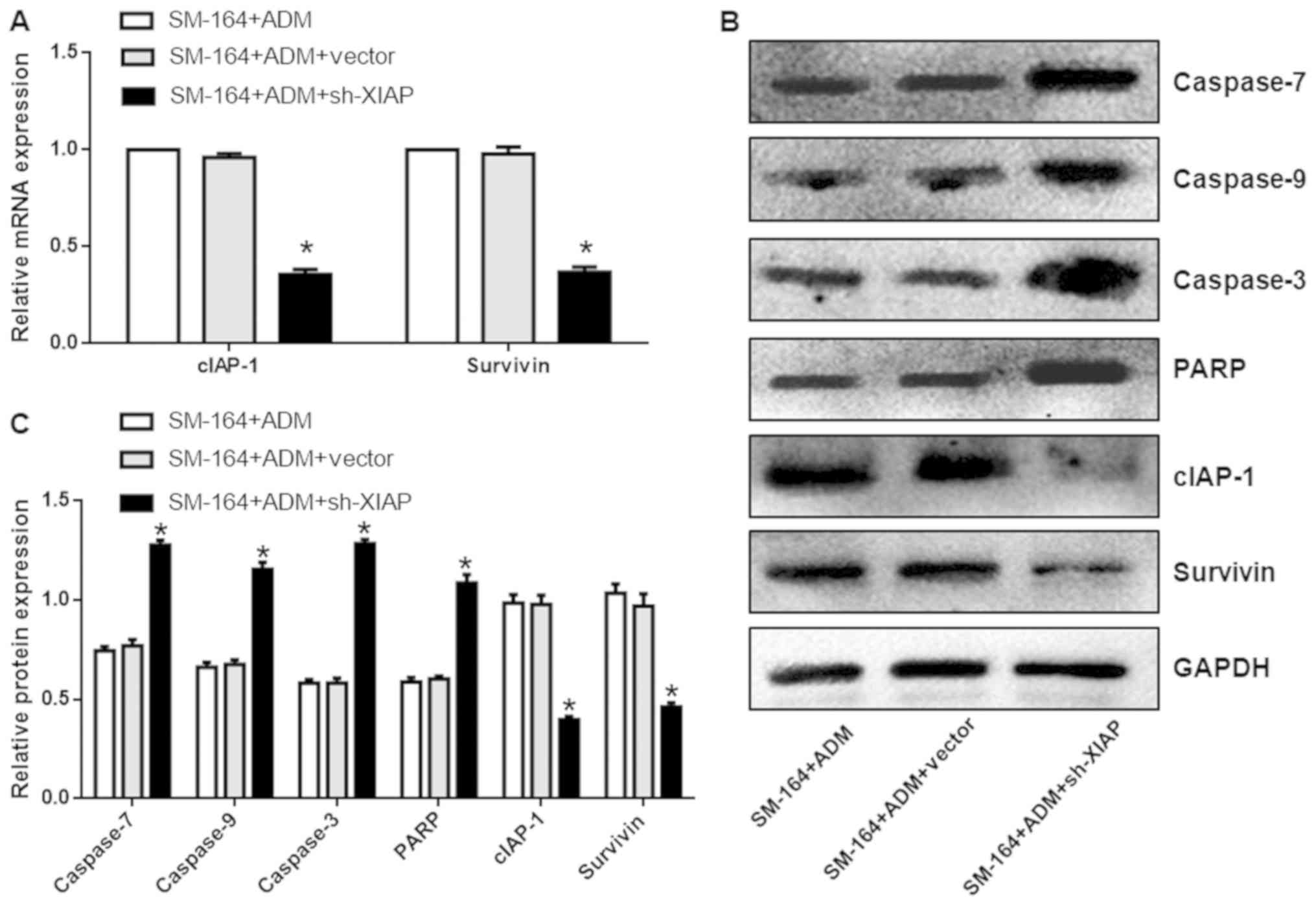|
1
|
Wang LL: Biology of osteogenic sarcoma.
Cancer J. 11:294–305. 2005. View Article : Google Scholar : PubMed/NCBI
|
|
2
|
Ryu K, Susa M, Choy E, Yang C, Hornicek
FJ, Mankin HJ and Duan Z: Oleanane triterpenoid CDDO-Me induces
apoptosis in multidrug resistant osteosarcoma cells through
inhibition of Stat3 pathway. BMC Cancer. 10:1872010. View Article : Google Scholar : PubMed/NCBI
|
|
3
|
Ramakrishnan V, Painuly U, Kimlinger T,
Haug J, Rajkumar SV and Kumar S: Inhibitor of apoptosis proteins as
therapeutic targets in multiple myeloma. Leukemia. 28:1519–1528.
2014. View Article : Google Scholar : PubMed/NCBI
|
|
4
|
Du C, Fang M, Li Y, Li L and Wang X: Smac,
a mitochondrial protein that promotes cytochrome c-dependent
caspase activation by eliminating IAP inhibition. Cell. 102:33–42.
2000. View Article : Google Scholar : PubMed/NCBI
|
|
5
|
Yao C, Wu S, Li D, Ding H, Wang Z, Yang Y,
Yan S and Gu Z: Co-administration phenoxodiol with doxorubicin
synergistically inhibit the activity of sphingosine kinase-1
(SphK1), a potential oncogene of osteosarcoma, to suppress
osteosarcoma cell growth both in vivo and in vitro. Mol Oncol.
6:392–404. 2012. View Article : Google Scholar : PubMed/NCBI
|
|
6
|
Chatterjee K, Zhang J, Honbo N and
Karliner JS: Doxorubicin cardiomyopathy. Cardiology. 115:155–162.
2010. View Article : Google Scholar : PubMed/NCBI
|
|
7
|
Sun H, Nikolovska-Coleska Z, Lu J, Meagher
JL, Yang CY, Qiu S, Tomita Y, Ueda Y, Jiang S, Krajewski K, et al:
Design, synthesis, and characterization of a potent, nonpeptide,
cell-permeable, bivalent Smac mimetic that concurrently targets
both the BIR2 and BIR3 domains in XIAP. J Am Chem Soc.
129:15279–15294. 2007. View Article : Google Scholar : PubMed/NCBI
|
|
8
|
Bai L, McEachern D, Yang CY, Lu J, Sun H
and Wang S: LRIG1 modulates cancer cell sensitivity to Smac
mimetics by regulating TNFα expression and receptor tyrosine kinase
signaling. Cancer Res. 72:1229–1238. 2012. View Article : Google Scholar : PubMed/NCBI
|
|
9
|
Lu J, Bai L, Sun H, Nikolovska-Coleska Z,
McEachern D, Qiu S, Miller RS, Yi H, Shangary S, Sun Y, et al:
SM-164: A novel, bivalent Smac mimetic that induces apoptosis and
tumor regression by concurrent removal of the blockade of cIAP-1/2
and XIAP. Cancer Res. 68:9384–9393. 2008. View Article : Google Scholar : PubMed/NCBI
|
|
10
|
Silke J and Meier P: Inhibitor of
apoptosis (IAP) proteins-modulators of cell death and inflammation.
Cold Spring Harb Perspect Biol. 5:2013. View Article : Google Scholar : PubMed/NCBI
|
|
11
|
Gowda Saralamma VV, Lee HJ, Raha S, Lee
WS, Kim EH, Lee SJ, Heo JD, Won C, Kang CK and Kim GS: Inhibition
of IAP's and activation of p53 leads to caspase-dependent apoptosis
in gastric cancer cells treated with Scutellarein. Oncotarget.
9:5993–6006. 2017.PubMed/NCBI
|
|
12
|
Werner TA, Nolten I, Dizdar L, Riemer JC,
Schütte SC, Verde PE, Raba K, Schott M, Knoefel WT and Krieg A:
IAPs cause resistance to TRAIL-dependent apoptosis in follicular
thyroid cancer. Endocr Relat Cancer. 25:295–308. 2018. View Article : Google Scholar : PubMed/NCBI
|
|
13
|
Tamanini E, Buck IM, Chessari G,
Chiarparin E, Day JEH, Frederickson M, Griffiths-Jones CM, Hearn K,
Heightman TD, Iqbal A, et al: Discovery of a potent
nonpeptidomimetic, small-molecule antagonist of cellular inhibitor
of apoptosis protein 1 (cIAP1) and X-linked inhibitor of apoptosis
protein (XIAP). J Med Chem. 60:4611–4625. 2017. View Article : Google Scholar : PubMed/NCBI
|
|
14
|
Dizdar L, Oesterwind KA, Riemer JC, Werner
TA, Mersch S, Möhlendick B, Schütte SC, Verde PE, Raba K, Topp SA,
et al: Preclinical assessment of survivin and XIAP as prognostic
biomarkers and therapeutic targets in gastroenteropancreatic
neuroendocrine neoplasia. Oncotarget. 8:8369–8382. 2017. View Article : Google Scholar : PubMed/NCBI
|
|
15
|
Zhu G, Wang X, Wu S and Li Q: Involvement
of activation of PI3K/Akt pathway in the protective effects of
puerarin against MPP+-induced human neuroblastoma SH-SY5Y cell
death. Neurochem Int. 60:400–408. 2012. View Article : Google Scholar : PubMed/NCBI
|
|
16
|
Livak KJ and Schmittgen TD: Analysis of
relative gene expression data using real-time quantitative PCR and
the 2(-Delta Delta C(T)) method. Methods. 25:402–408. 2001.
View Article : Google Scholar : PubMed/NCBI
|
|
17
|
Zhu G, Li J, He L, Wang X and Hong X:
MPTP-induced changes in hippocampal synaptic plasticity and memory
are prevented by memantine through the BDNF-TrkB pathway. Br J
Pharmacol. 172:2354–2368. 2015. View Article : Google Scholar : PubMed/NCBI
|
|
18
|
LaBarre DD and Lowy RJ: Improvements in
methods for calculating virus titer estimates from TCID50 and
plaque assays. J Virol Methods. 96:107–126. 2001. View Article : Google Scholar : PubMed/NCBI
|
|
19
|
Wittig JC, Bickels J, Priebat D, Jelinek
J, Kellar-Graney K, Shmookler B and Malawer MM: Osteosarcoma: A
multidisciplinary approach to diagnosis and treatment. Am Fam
Physician. 65:1123–1132. 2002.PubMed/NCBI
|
|
20
|
Gewirtz DA: A critical evaluation of the
mechanisms of action proposed for the antitumor effects of the
anthracycline antibiotics adriamycin and daunorubicin. Biochem
Pharmacol. 57:727–741. 1999. View Article : Google Scholar : PubMed/NCBI
|
|
21
|
Jung K and Reszka R: Mitochondria as
subcellular targets for clinically useful anthracyclines. Adv Drug
Deliv Rev. 49:87–105. 2001. View Article : Google Scholar : PubMed/NCBI
|
|
22
|
Hurley LH: DNA and its associated
processes as targets for cancer therapy. Nat Rev Cancer. 2:188–200.
2002. View
Article : Google Scholar : PubMed/NCBI
|
|
23
|
Pilling AB, Hwang O, Boudreault A, Laurent
A and Hwang C: IAP antagonists enhance apoptotic response to
enzalutamide in castration-resistant prostate cancer cells via
autocrine TNF-α signaling. Prostate. 77:866–877. 2017. View Article : Google Scholar : PubMed/NCBI
|
|
24
|
Yang D, Zhao Y, Li AY, Wang S, Wang G and
Sun Y: Smac-mimetic compound SM-164 induces radiosensitization in
breast cancer cells through activation of caspases and induction of
apoptosis. Breast Cancer Res Treat. 133:189–199. 2012. View Article : Google Scholar : PubMed/NCBI
|
|
25
|
Jiang J, Yang Z, Fan C, Sun H and Yang D:
SMAC mimetic SM-164 enhanced adriamycin induced apoptosis and cell
cycle arrest in osteosarcoma cell line HOS. Int J Clin Exp Med.
10:2818–2825. 2017.
|
|
26
|
Schwerd T, Pandey S, Yang HT, Bagola K,
Jameson E, Jung J, Lachmann RH, Shah N, Patel SY, Booth C, et al:
Impaired antibacterial autophagy links granulomatous intestinal
inflammation in Niemann-Pick disease type C1 and XIAP deficiency
with NOD2 variants in Crohn's disease. Gut. 66:1060–1073. 2017.
View Article : Google Scholar : PubMed/NCBI
|
|
27
|
Shiozaki EN, Chai J, Rigotti DJ, Riedl SJ,
Li P, Srinivasula SM, Alnemri ES, Fairman R and Shi Y: Mechanism of
XIAP-mediated inhibition of caspase-9. Mol Cell. 11:519–527. 2003.
View Article : Google Scholar : PubMed/NCBI
|
|
28
|
Lin YF, Lai TC, Chang CK, Chen CL, Huang
MS, Yang CJ, Liu HG, Dong JJ, Chou YA, Teng KH, et al: Targeting
the XIAP/caspase-7 complex selectively kills caspase-3-deficient
malignancies. J Clin Invest. 123:3861–3875. 2013. View Article : Google Scholar : PubMed/NCBI
|















